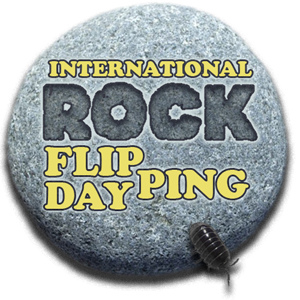Pill bugs, rolypolies, wood lice, potato bugs or isopods, these cute little crustaceans come with a bunch of common names. Add the names for their close cousins the sow bugs (the ones that can’t roll up) and the shore isopods called slaters, and you have a dictionary full.


What do you call these seashore isopods?
Today we’re going to be using pill bugs, the ones that look like a pill when they roll up.
Although most people associate pill bugs with moist environments, surprisingly we have pill bugs in the desert that can tolerate a much drier climate. They are common and active residents of our back yard, although they do seem to prefer the irrigated areas.

Pill bugs are fun to investigate. First, prepare a temporary holding container with a walnut-sized wad of moist paper towel and a few bits of carrot for food. Look outside under stones or logs for pill bugs. Note: always return the rocks or logs to their original position when through, and be careful if you live where there are poisonous critters that live under rocks. You might want to tip them with a bar.
When you find some pill bugs, gently transfer them to the container. After they unroll, you can look at them through a magnifying lens. Study how they move and their body parts.
Check the “Using Live Insects in the Classroom” Isopod Information Sheet for a detailed description of their morphology.
1. Draw or build a model pill bug.
Gather materials such a paper, cardboard, chenilles and/or clay and create a pill bug model. Pay particular attention to what they look like, because the more details you add, the more realistic the model will be.
2. Do all your pill bugs look alike? We found some of ours were entirely dark gray whereas others had gold or yellow spots on their backs.

Any ideas why pill bugs might be different colors?
3. When the pill bugs roll up, can you still see their antennae? Our desert pill bugs can roll up with their antennae inside, other species can’t. Why might that be?
4. Build a simple maze and test some of your ideas about pill bugs. We built ours out of light cardboard, like a cereal box. We taped it down with masking tape so it wouldn’t fall on the pill bugs. Be careful that no sticky edges are exposed, because the pill bugs might get stuck. We also found certain pill bugs wouldn’t cross the masking tape, so try to keep the tape on the outside of the maze. While planning, you might want to sketch your maze on graph paper or use a computer.
We tested the idea that pill bugs would prefer darkness to light. We also offered them different types of food.
In the video, we wondered if the pill bugs would explore a complex maze with a lot of turns to find food. We set two pill bugs in the maze entrance together. See what happened:
We had fun and learned a lot about how pill bugs behave. Hope you give it a try.
Once we were done, the pill bugs went back to nature unharmed.
For more information and great science activities with pill bugs, I highly recommend:
Rolypolyology (Backyard Buddies) by Michael Elsohn Ross, and illustrated by Darren Erickson
It seems to be out of press, but you should be able to find it at your local library. It is filled with fantastic ideas.
Other pill bug books (linked images and titles go to Amazon):
A Pill Bug’s Life (Nature Upclose) by John Himmelman
The Pillbug Project: A Guide to Investigation by Robin Burnett
I’m a Pill Bug (Nature: a Child’s Eye View) (Nature: a Child’s Eye View) by Yukihisa Tokuda, and illustrated by Kiyoshi Takahasi
Nature Close-Up – Pill Bugs & Sow Bugs and Other Custaceans by Elaine Pascoe
Pill Bugs Up Close (Minibeasts Up Close) (Perspectives) by Greg Pyers
Compost Critters by Bianca Lavies is an excellent introduction to composting. Although it is an older book, the photographs are excellent.











 I’m a bit late with this one, but Sunday September 20 is International Rock Flipping Day. Visit
I’m a bit late with this one, but Sunday September 20 is International Rock Flipping Day. Visit 